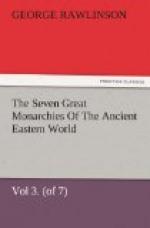The narrow tract of which this is a description can at no time have sheltered a very numerous or powerful people. During the Median period, and for many ages afterwards, it seems to have been inhabited by various petty tribes of predatory habits—Cadusians, Mardi, Tapyri, etc.,—who passed their time in petty quarrels among themselves, and in plundering raids upon their great southern neighbor. Of these tribes the Cadusians alone enjoyed any considerable reputation. They were celebrated for their skill with the javelin—a skill probably represented by the modern Persian use of the djereed. According to Diodorus, they were engaged in frequent wars with the Median kings, and were able to bring into the field a force of 200,000 men! Under the Persians they seem to have been considered good soldiers, and to have sometimes made a struggle for independence. But there is no real reason to believe that they were of such strength as to have formed at any time a danger to the Median kingdom, to which it is more probable that they generally acknowledged a qualified subjection.
The great country of Armenia, which lay north-west and partly north of Media, has been generally described in the first volume; but a few words will be here added with respect to the more eastern portion, which immediately bordered upon the Median territory. This consisted of two outlying districts, separated from the rest of the country, the triangular basin of Lake Van, and the tract between the Kur and Aras rivers—the modern Karabagh and Erivan. The basin of Lake Van, surrounded by high ranges, and forming the very heart of the mountain system of this part of Asia, is an isolated region, a sort of natural citadel, where a strong military power would be likely to establish itself. Accordingly it is here, and here alone in all Armenia, that we find signs of the existence, during the Assyrian and Median periods, of a great organized monarchy.
The Van inscriptions indicate to us a line of kings who bore sway in the eastern Armenia—the true Ararat—and who were both in civilization and in military strength far in advance of any of the other princes who divided among them the Armenian territory. The Van monarchs may have been at times formidable enemies of the Medes. They have left traces of their dominion, not only on the tops of the mountain passes which lead into the basin of




